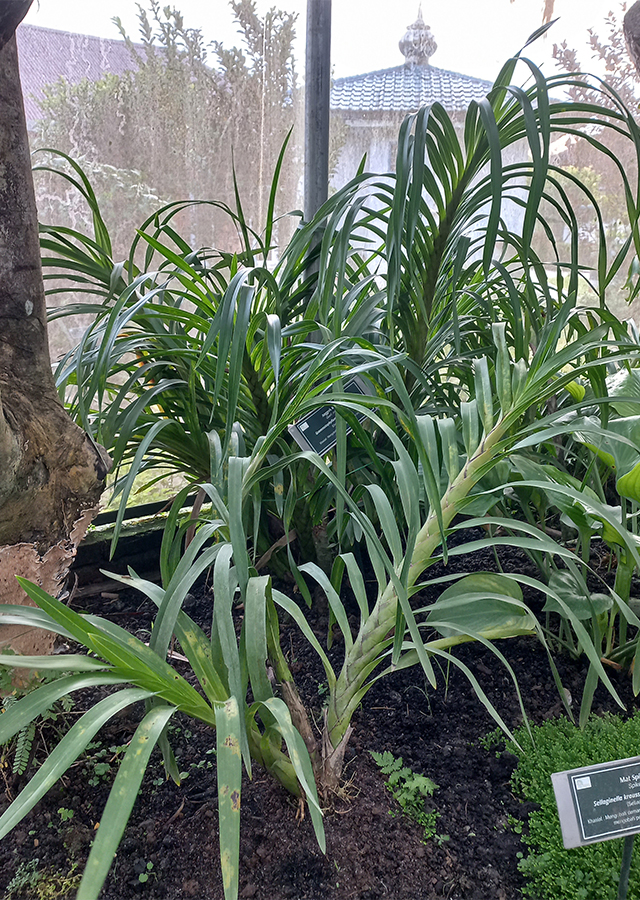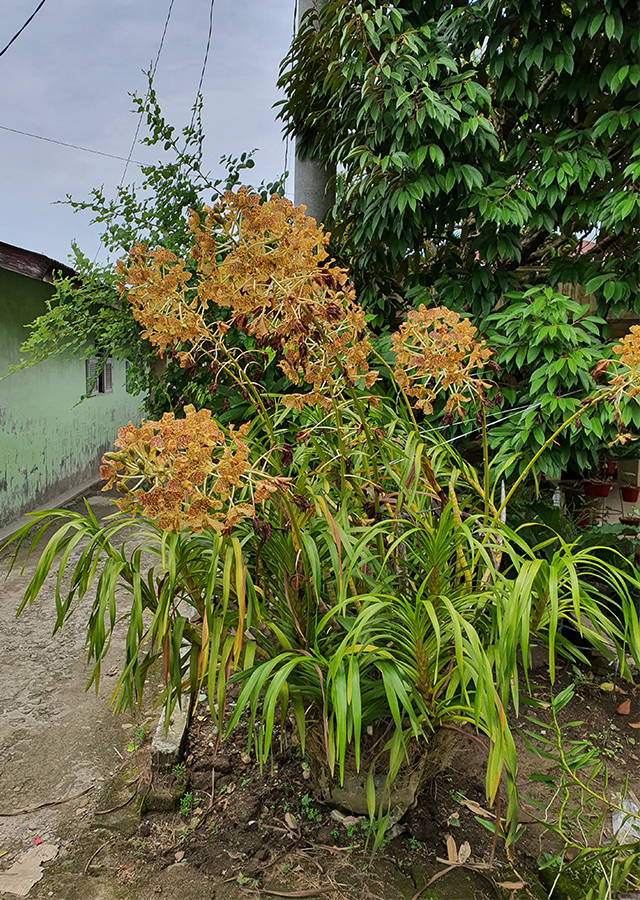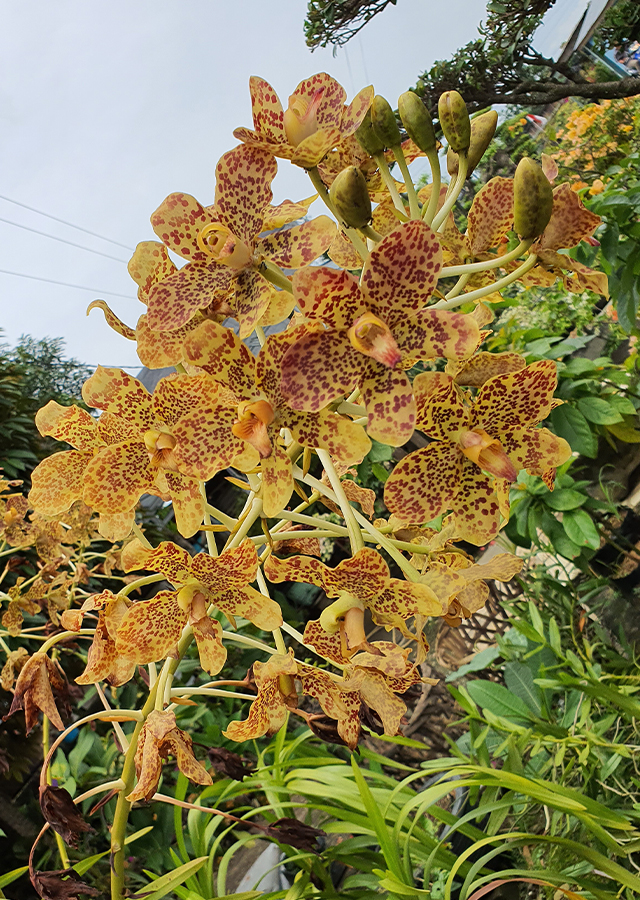Tiger Orchid
Grammatophyllum speciosum Blume
Orchidaceae
Location in our garden
Orchard



Synonym
Grammatophyllum fastuosum Lindl.
Grammatophyllum macranthum (Wight) Rchb.f.
Grammatophyllum giganteum Blume ex Rchb.f.
Habitus
Orchid. A large, clumping, epiphytic perennial orchid, growing up to 7 m tall.
Part Used
Leaves
Stem
Pseudobulb
Growing Requirements
Full Sunshine
Need Shade
Habitat
Forest
Terrestrial
Overview
Grammatophyllum speciosum is the largest orchid species in the world, with its clump weighing as heavy as two tonnes, and bearing flower stalks as long as 2 m long. The common name, Tiger Orchid is given after the striking brown and yellow flower patterns resembling tiger stripes. This "Queen of Orchids" is native to South-East Asia and Papua New Guinea. Listed by the Guinness Book of World Records as the world’s tallest orchid with specimens up to 7.62 m tall. It is used as a pain reliever in traditional medicine and as ornamental as well.
Vernacular Names
Bunga bidadari (Malaysia).
Agroecology
Minimum water needs. Requires occasional misting. However, it needs plenty of water and high humidity during the growing season but less water during the cooler months. Grows best in full sun to partial shade. Grammatophyllum speciosum should be kept at a minimum of 15 °C, provided with good light and watered heavily throughout the year, with a slight reduction in watering during winter when the temperature should be reduced to 18 °C. Plants will tolerate temperatures to 10 °C and up to 38 °C for short periods. At higher temperatures, air circulation and humidity must be increased or damage can occur. The ideal annual temperature range for Grammatophyllum speciosum orchid are 15 to 25 °C. If the temperature is too low or too high, it will affect the growth and development of the plant. In very mild climates, this beauty can be grown outdoors, with protection from the hot summer sun and the colder nights of winter.
Morphology
- Stem - fleshy, 3 m or longer and up to 5 cm thick. Its cylindrical pseudobulbs can grow up to 2.5 m long, bearing up to eighty flowers.
- Leaves - stalkless, smooth, green, entire margins, sesille, parallel venation, simple foliar, alternate, two-rowed leaves have thin leaf blades that are strap-like, narrowing and curving downwards towards the sharp tips, and 31–60 by 2.5–3 cm.
- Flowers - bisexual, 10 cm-wide flowers are borne on an elongated shoot from the base of the stem. Both its sepals and petals are pale greenish-yellow with orange-brown spots, turning darker when older. The floral stalk is about 2 m tall and carries about 40 long-lasting flowers.
- Fruit - simple brown, dehiscent dry pear-shaped fruit, and about 15 cm long.
- Seed - many tiny seeds.
Cultivation
Generative propagation is by seeds, and vegetatively by division. Always divide the plants into parts with at least four pseudobulbs and remove any dead roots from the divisions. Fertiliser should be applied regularly throughout the year, with a higher nitrogen content in summer, and with reduced nitrogen but increased potassium content during late autumn to early spring.
Chemical Constituents
Isovitexin, grammatophyllosides, glucosyloxybenzyl derivatives, vandateroside II, cronupapine, vanilloloside, gastodin, and orcinolglucoside.
Traditional Medicinal Uses
- The extract of the pseudobulb is used to relieve pain from scorpion stings and recently reported the antiaging effect, and also can stimulate wound healing in human skin primal fibroblast cells.
- Study showed antiproliferation effects on human breast cancer cells. The development of G. speciosum for breast cancer treatment in combination with standard therapy deserves further study.
- In Papua (Indonesia), it has been used to treat several diseases, such as cysts.
Part Used
Reference Sources
- Chowjarean, V., Sadabpod, K. (2021). Antiproliferative Effect of Grammatophyllum speciosum Ethanolic Extract and Its Bioactive Compound on Human Breastate) Cancer Cells. Scientific World Journal. doi: 10.1155/2021/3752169.
- John&Jacq~s Garden. (No date). Grammatophyllum speciosum (Giant Orchid, Tiger Orchid, Sugar Cane Orchid, Queen of the Orchids). https://www.jaycjayc.com/grammatophyllum-speciosum-giant-orchid/. 05-01-2022.
- Kew Royal Botanic Gardens. (2021). Plants of the World Online: Grammatophyllum speciosum Blume. http://www.plantsoftheworldonline.org/taxon/urn:lsid:ipni.org:names:636310-1. 05-01-2022.
- National Park of Singapore. (2021). Flora Fauna Web: Grammatophyllum speciosum. https://www.nparks.gov.sg/florafaunaweb/flora/2/0/2041. 05-01-2022.


